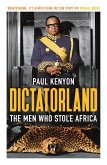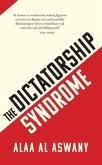Daron Acemoglu (Massachusetts Institute of Technology), James A. Robinson (Massachusetts Harvard University)
Economic Origins of Dictatorship and Democracy
28,99 €
inkl. MwSt.
Sofort lieferbar

14 °P sammeln
Daron Acemoglu (Massachusetts Institute of Technology), James A. Robinson (Massachusetts Harvard University)
Economic Origins of Dictatorship and Democracy
- Broschiertes Buch
- Merkliste
- Auf die Merkliste
- Bewerten Bewerten
- Teilen
- Produkt teilen
- Produkterinnerung
- Produkterinnerung
This book is the first to use modern social science methodology systematically to explain why some countries are democracies while others are not. Why does democracy sometimes persist and consolidate while other times it collapses? The treatment shows that whether or not a society becomes democratic depends on several factors.
Andere Kunden interessierten sich auch für
![Dark Shadows Dark Shadows]() Joanna LillisDark Shadows44,99 €
Joanna LillisDark Shadows44,99 €![Italy Reborn Italy Reborn]() Mark GilbertItaly Reborn28,99 €
Mark GilbertItaly Reborn28,99 €![How to Rig an Election How to Rig an Election]() Nic CheesemanHow to Rig an Election11,99 €
Nic CheesemanHow to Rig an Election11,99 €![Dictatorland Dictatorland]() Paul KenyonDictatorland10,99 €
Paul KenyonDictatorland10,99 €![Spin Dictators Spin Dictators]() Daniel TreismanSpin Dictators16,99 €
Daniel TreismanSpin Dictators16,99 €![The Dictatorship Syndrome The Dictatorship Syndrome]() Alaa Al AswanyThe Dictatorship Syndrome21,99 €
Alaa Al AswanyThe Dictatorship Syndrome21,99 €![Egypt under El-Sisi Egypt under El-Sisi]() Maged Mandour (Independent Researcher)Egypt under El-Sisi17,99 €
Maged Mandour (Independent Researcher)Egypt under El-Sisi17,99 €-
-
-
This book is the first to use modern social science methodology systematically to explain why some countries are democracies while others are not. Why does democracy sometimes persist and consolidate while other times it collapses? The treatment shows that whether or not a society becomes democratic depends on several factors.
Hinweis: Dieser Artikel kann nur an eine deutsche Lieferadresse ausgeliefert werden.
Hinweis: Dieser Artikel kann nur an eine deutsche Lieferadresse ausgeliefert werden.
Produktdetails
- Produktdetails
- Verlag: Cambridge University Press
- Seitenzahl: 434
- Erscheinungstermin: 28. Mai 2009
- Englisch
- Abmessung: 234mm x 156mm x 23mm
- Gewicht: 600g
- ISBN-13: 9780521671422
- ISBN-10: 0521671426
- Artikelnr.: 25617523
- Herstellerkennzeichnung
- Libri GmbH
- Europaallee 1
- 36244 Bad Hersfeld
- gpsr@libri.de
- Verlag: Cambridge University Press
- Seitenzahl: 434
- Erscheinungstermin: 28. Mai 2009
- Englisch
- Abmessung: 234mm x 156mm x 23mm
- Gewicht: 600g
- ISBN-13: 9780521671422
- ISBN-10: 0521671426
- Artikelnr.: 25617523
- Herstellerkennzeichnung
- Libri GmbH
- Europaallee 1
- 36244 Bad Hersfeld
- gpsr@libri.de
Daron Acemoglu is Charles P. Kindleberger Professor of Applied Economics at The Massachusetts Institute of Technology and a member of the Canadian Institute for Advanced Research's Program on Institutions, Organizations, and Growth. He received the 2005 John Bates Clark Medal awarded by the American Economic Association to the best economist working in the United States under age 40. He is the author of the textbook Introduction to Modern Economic Growth and coeditor of Econometrica and NBER Macroannual.
Part I. Questions and Answers; Section 1. Paths of Political Development: 1. Britain; 2. Argentina; 3. Singapore; 4. South Africa, 5. The agenda; Section 2. Our Argument: 1. Democracy vs. nondemocracy; 2. Building blocks of our approach; 3. Towards our basic story; 4. Our theory of democratization; 5. Democratic consolidation; 6. Determinants of democracy; 7. Political identities and the nature of conflict; 8. Democracy in a picture; 9. Overview of the book; Section 3. What Do We Know About Democracy?: 1. Measuring democracy; 2. Patterns of democracy; 3. Democracy, inequality and redistribution; 4. Crises and democracy; 5. Social unrest and democratization; 6. The literature; 7. Our contribution; Part II. Modelling Politics; Section 4. Democratic Politics: 1. Introduction; 2. Aggregating individual preferences; 3. Single-peaked preferences and the median voter theorem; 4. Our workhorse models; 5. Democracy and political equality; 6. Conclusion; Section 5. Nondemocratic Politics: 1. Introduction; 2. Power and constraints in nondemocratic politics; 3. Modeling preferences and constraints in nondemocracies; 4. Commitment problems; 5. A simple game of promises; 6. A dynamic model; 7. Incentive compatible promises; 8. Conclusion; Part III. The Creation and Consolidation of Democracy; Section 6. Democratization: 1. Introduction; 2. The role of political institutions; 3. Preferences over political institutions; 4. Political power and institutions; 5. A 'static' model of democratization; 6. Democratization or repression?; 7. A dynamic model of democratization; 8. Subgame perfect equilibria; 9. Alternative political identities; 10. Targeted transfers; 11. Power of the elite in democracy; 12. Ideological preferences over regimes; 13. Democratization in pictures; 14. Equilibrium revolutions; 15. Conclusion; Section 7. Coups and Consolidation: 1. Introduction; 2. Incentives for coups; 3. A static model of coups; 4. A dynamic model of the creation and consolidation of democracy; 5. Alternative political identities; 6. Targeted transfers; 7. Power in democracy and coups; 8. Consolidation in a picture; 9. Defensive coups; 10. Conclusion; Part IV. Putting the Models to Work; Section 8. The Role of the Middle Class: 1. Introduction; 2. The three-class model; 3. Emergence of partial democracy; 4. From partial to full democracy; 5. Repression: the middle class as a buffer; 6. Repression: soft-liners vs. hard-liners; 7. The role of the middle class in consolidating democracy; 8. Conclusion; Section 9. Economic Structure and Democracy: 1. Introduction; 2. Economic structure and income distribution; 3. Political conflict; 4. Capital, land and the transition to democracy; 5. Financial integration; 6. Increased political integration; 7. Alternative assumptions about the nature of international trade. 8. Conclusion; Part V. Conclusion and The Future of Democracy; Section 10. Conclusion and the Future of Democracy: 1. Paths of political development revisited; 2. Extension and areas for future research; 3. The future of democracy; Part VI. Appendix; Section 11. Appendix to Section 4: The Distribution of Power in Democracy: 1. Introduction; 2. Probabilistic voting models; 3. Lobbying; 4. Partisan politics and political capture.
Part I. Questions and Answers; Section 1. Paths of Political Development: 1. Britain; 2. Argentina; 3. Singapore; 4. South Africa, 5. The agenda; Section 2. Our Argument: 1. Democracy vs. nondemocracy; 2. Building blocks of our approach; 3. Towards our basic story; 4. Our theory of democratization; 5. Democratic consolidation; 6. Determinants of democracy; 7. Political identities and the nature of conflict; 8. Democracy in a picture; 9. Overview of the book; Section 3. What Do We Know About Democracy?: 1. Measuring democracy; 2. Patterns of democracy; 3. Democracy, inequality and redistribution; 4. Crises and democracy; 5. Social unrest and democratization; 6. The literature; 7. Our contribution; Part II. Modelling Politics; Section 4. Democratic Politics: 1. Introduction; 2. Aggregating individual preferences; 3. Single-peaked preferences and the median voter theorem; 4. Our workhorse models; 5. Democracy and political equality; 6. Conclusion; Section 5. Nondemocratic Politics: 1. Introduction; 2. Power and constraints in nondemocratic politics; 3. Modeling preferences and constraints in nondemocracies; 4. Commitment problems; 5. A simple game of promises; 6. A dynamic model; 7. Incentive compatible promises; 8. Conclusion; Part III. The Creation and Consolidation of Democracy; Section 6. Democratization: 1. Introduction; 2. The role of political institutions; 3. Preferences over political institutions; 4. Political power and institutions; 5. A 'static' model of democratization; 6. Democratization or repression?; 7. A dynamic model of democratization; 8. Subgame perfect equilibria; 9. Alternative political identities; 10. Targeted transfers; 11. Power of the elite in democracy; 12. Ideological preferences over regimes; 13. Democratization in pictures; 14. Equilibrium revolutions; 15. Conclusion; Section 7. Coups and Consolidation: 1. Introduction; 2. Incentives for coups; 3. A static model of coups; 4. A dynamic model of the creation and consolidation of democracy; 5. Alternative political identities; 6. Targeted transfers; 7. Power in democracy and coups; 8. Consolidation in a picture; 9. Defensive coups; 10. Conclusion; Part IV. Putting the Models to Work; Section 8. The Role of the Middle Class: 1. Introduction; 2. The three-class model; 3. Emergence of partial democracy; 4. From partial to full democracy; 5. Repression: the middle class as a buffer; 6. Repression: soft-liners vs. hard-liners; 7. The role of the middle class in consolidating democracy; 8. Conclusion; Section 9. Economic Structure and Democracy: 1. Introduction; 2. Economic structure and income distribution; 3. Political conflict; 4. Capital, land and the transition to democracy; 5. Financial integration; 6. Increased political integration; 7. Alternative assumptions about the nature of international trade. 8. Conclusion; Part V. Conclusion and The Future of Democracy; Section 10. Conclusion and the Future of Democracy: 1. Paths of political development revisited; 2. Extension and areas for future research; 3. The future of democracy; Part VI. Appendix; Section 11. Appendix to Section 4: The Distribution of Power in Democracy: 1. Introduction; 2. Probabilistic voting models; 3. Lobbying; 4. Partisan politics and political capture.







